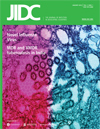Neonatal septicemia isolates and resistance patterns in a tertiary care hospital of North India
DOI:
https://doi.org/10.3855/jidc.625Keywords:
Neonates, Septicemia, Bacteriology, Antimicrobial susceptibilityAbstract
Background: Septicemia continues to be a major cause of neonatal mortality and morbidity worldwide. Methodology: To know the rate of neonatal septicemia in our tertiary care centre, a retrospective analysis of 2,247 blood samples was done over a period of four years and three months (July 2003 to October 2007). Results: During that period, a total of 296 (13.17%) blood samples were found to be positive for bacterial isolates. Gram-negative septicemia (80.40%) was identified in more cases than Gram-positive septicemia (20.60%) with Klebsiella species 84 (28.3%) being the most common isolate. Maximum resistance among Gram-negative organisms was seen in amoxycillin/ampicillin and third-generation cephalosporins. Amikacin, cefoperazone/sulbactam and imipenem were found to be good alternative drugs. Among Gram-positive organisms, all strains were sensitive to Vancomycin.
Conclusion: Continued surveillance for various pathogens and their susceptibility profile should be done to effectively and timely treat the patients of neonatal septicaemia.
Downloads
Published
How to Cite
Issue
Section
License
Authors who publish with this journal agree to the following terms:
- Authors retain copyright and grant the journal right of first publication with the work simultaneously licensed under a Creative Commons Attribution License that allows others to share the work with an acknowledgement of the work's authorship and initial publication in this journal.
- Authors are able to enter into separate, additional contractual arrangements for the non-exclusive distribution of the journal's published version of the work (e.g., post it to an institutional repository or publish it in a book), with an acknowledgement of its initial publication in this journal.
- Authors are permitted and encouraged to post their work online (e.g., in institutional repositories or on their website) prior to and during the submission process, as it can lead to productive exchanges, as well as earlier and greater citation of published work (See The Effect of Open Access).








